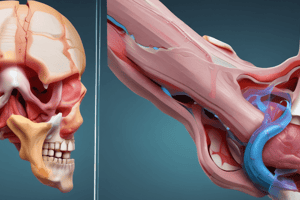Podcast
Questions and Answers
What is the primary difference between open and closed fractures?
What is the primary difference between open and closed fractures?
- Closed fractures have a higher risk of infection than open fractures
- Closed fractures are caused by twisting the joint, while open fractures involve powerful forces
- Open fractures involve open wounds, while closed fractures leave the skin unbroken (correct)
- Open fractures are more common than closed fractures
What is a dislocation?
What is a dislocation?
- A fracture where the skin is unbroken
- A displacement or separation of a bone from its normal position at a joint (correct)
- A type of injury that always involves open wounds
- A bone that is forced beyond its normal position without tearing ligaments
Why are some joints like the shoulder more prone to dislocation?
Why are some joints like the shoulder more prone to dislocation?
- Because they have less range of motion
- Because they are well protected from injury
- Because they are exposed to strong forces more often (correct)
- Because they are less flexible than other joints
What can cause hypovolemic shock in cases of large bone fractures?
What can cause hypovolemic shock in cases of large bone fractures?
Why are open fractures considered more serious than closed fractures?
Why are open fractures considered more serious than closed fractures?
How do ligaments play a role in subsequent dislocations of a joint?
How do ligaments play a role in subsequent dislocations of a joint?
What is the most common type of injury to the shoulder?
What is the most common type of injury to the shoulder?
Why is it important to ensure blood flow and nerve function are not impaired in upper extremity injuries?
Why is it important to ensure blood flow and nerve function are not impaired in upper extremity injuries?
Which structure is least likely to be affected by scapular fractures?
Which structure is least likely to be affected by scapular fractures?
What is the primary indicator of a possible scapular fracture?
What is the primary indicator of a possible scapular fracture?
What should be done if a splint applied to an injured area is too tight?
What should be done if a splint applied to an injured area is too tight?
Which bones meet to form the shoulder joint?
Which bones meet to form the shoulder joint?
What type of soft tissue structures do strains involve?
What type of soft tissue structures do strains involve?
What is crepitus, as mentioned in the text?
What is crepitus, as mentioned in the text?
What is a key indicator suggesting a fracture, according to the text?
What is a key indicator suggesting a fracture, according to the text?
How are sprains different from fractures?
How are sprains different from fractures?
What is a common cause of crepitus in cases of fracture?
What is a common cause of crepitus in cases of fracture?
Why should a patient with musculoskeletal injuries be examined by a physician?
Why should a patient with musculoskeletal injuries be examined by a physician?
What is the purpose of padding the splint when using a rigid or anatomical splint?
What is the purpose of padding the splint when using a rigid or anatomical splint?
When immobilizing an injured part with a splint, how should it be secured in place?
When immobilizing an injured part with a splint, how should it be secured in place?
Why is it important to move from stable to unstable areas when attaching a splint?
Why is it important to move from stable to unstable areas when attaching a splint?
In the case of a broken elbow, where should you begin securing the splint?
In the case of a broken elbow, where should you begin securing the splint?
Why should a moldable splint be shaped to the uninjured extremity before transferring it to the injured side?
Why should a moldable splint be shaped to the uninjured extremity before transferring it to the injured side?
What is the purpose of extending a splint above and below the injury site?
What is the purpose of extending a splint above and below the injury site?
What is a common characteristic deformity associated with a fractured femur?
What is a common characteristic deformity associated with a fractured femur?
When is it recommended to secure the injured leg to the uninjured leg as an anatomical splint?
When is it recommended to secure the injured leg to the uninjured leg as an anatomical splint?
What should be done to reduce the risk of injury when using a blanket as an anatomical splint?
What should be done to reduce the risk of injury when using a blanket as an anatomical splint?
How should the knees be supported if the patient is not on a rigid device like a backboard?
How should the knees be supported if the patient is not on a rigid device like a backboard?
What bones are often involved in a lower leg fracture?
What bones are often involved in a lower leg fracture?
What method can be used to immobilize an injured leg effectively?
What method can be used to immobilize an injured leg effectively?




